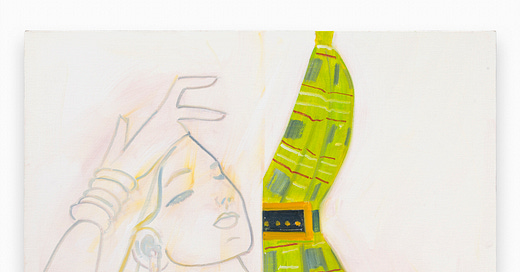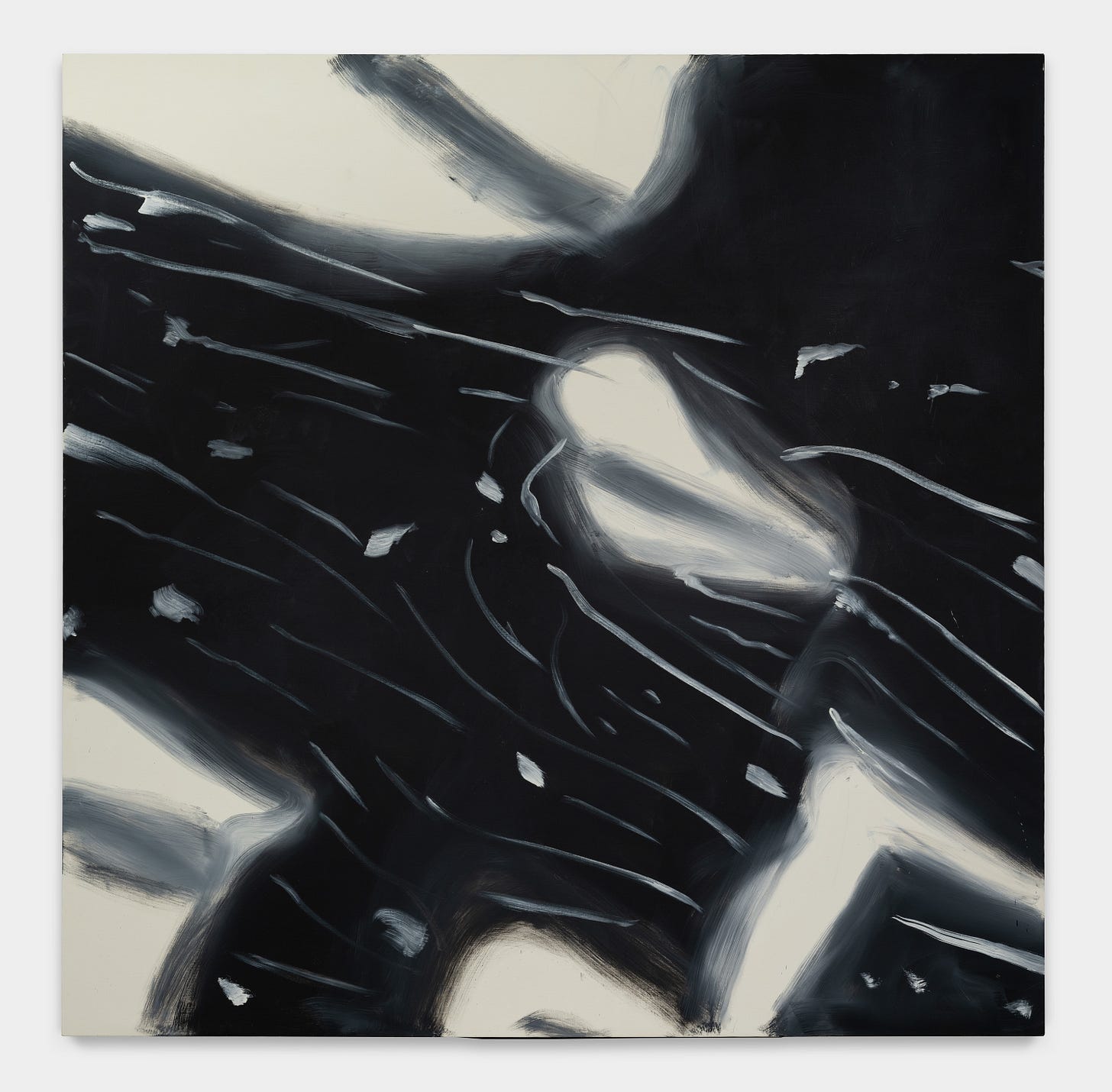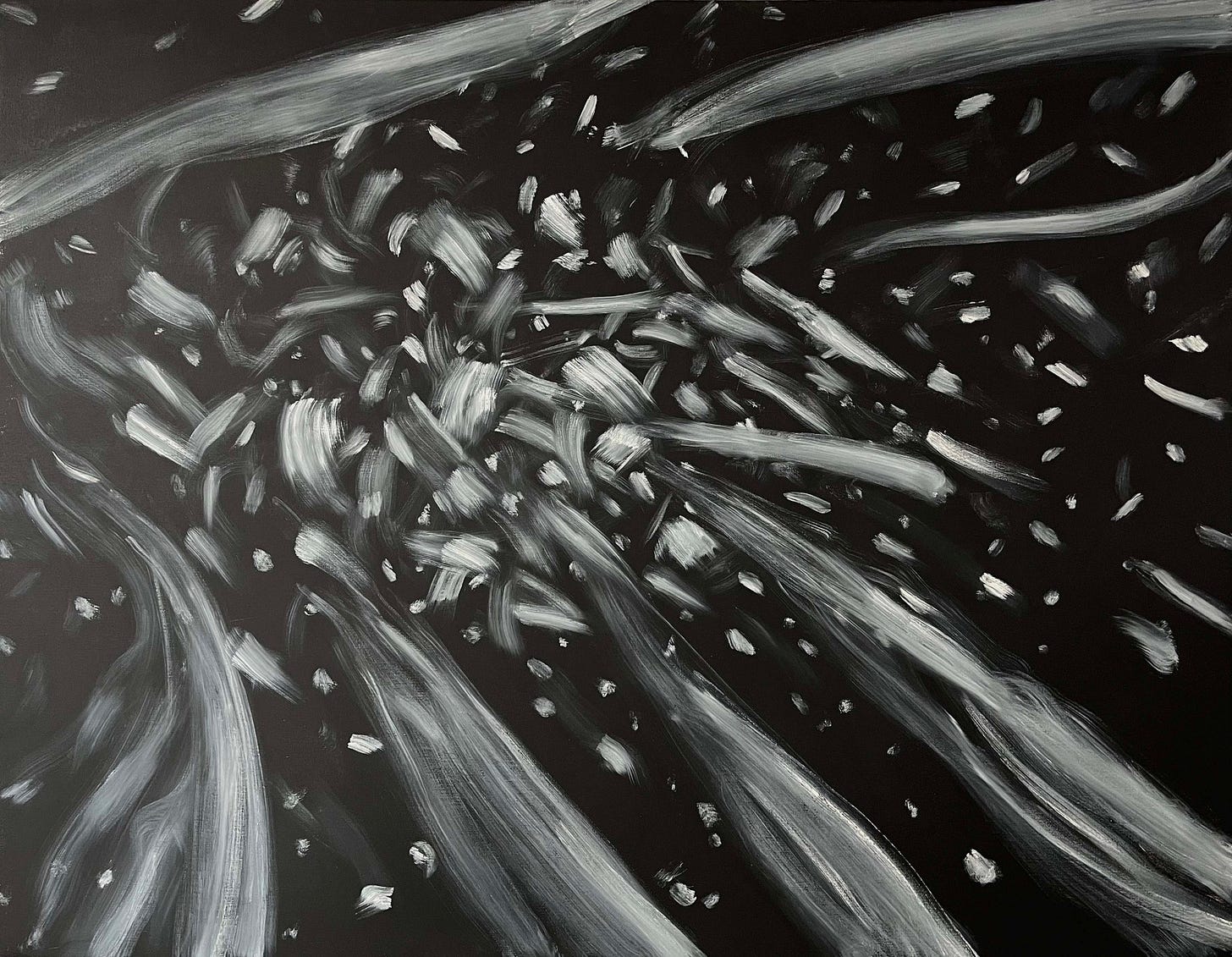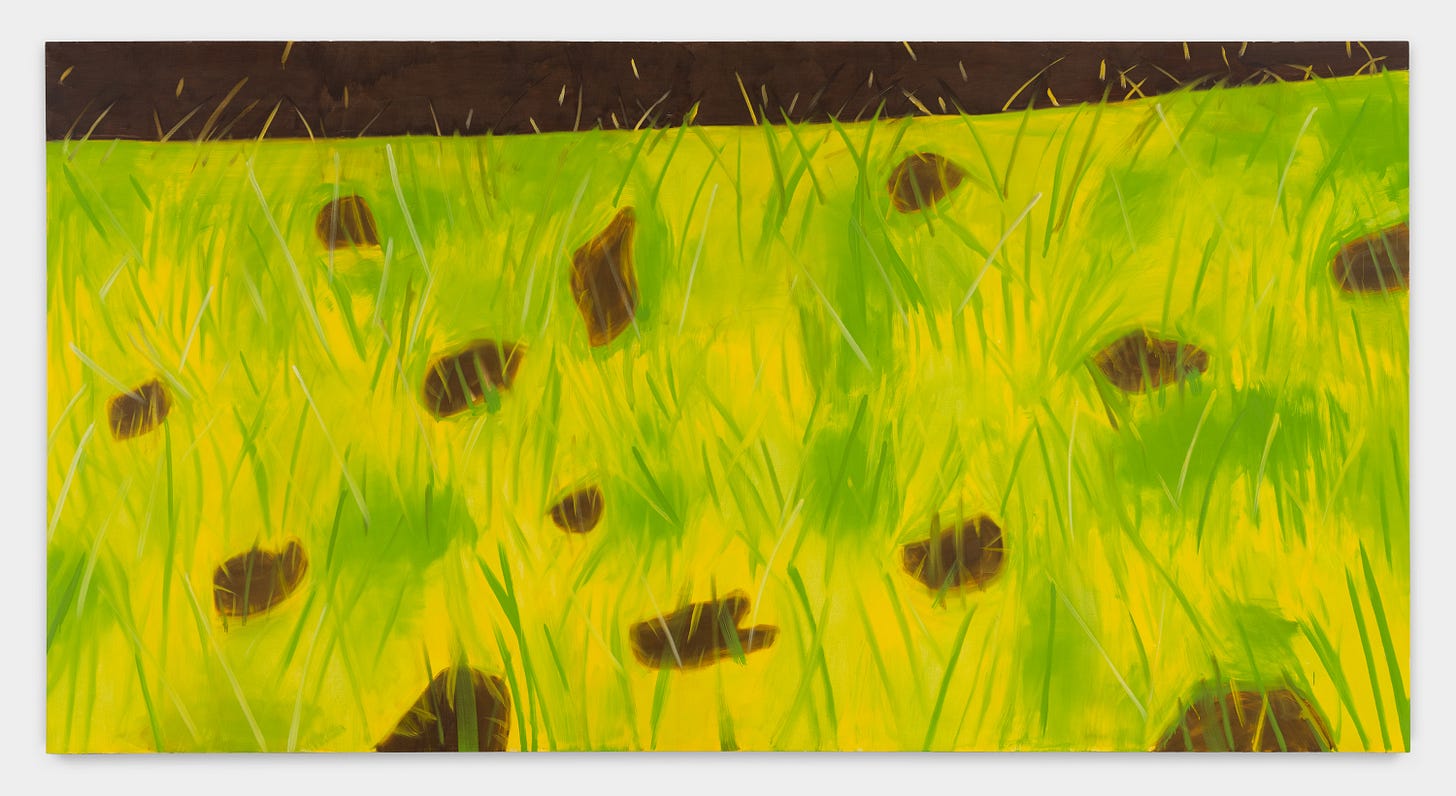I'm Tired of This, Grandpa: Alex Katz in Venice
What do water, grass, and an American fashion designer have in common? A painter unable to deliver the punchline to a joke.
Alex (Greatest Generation, American) paints flat close-ups, most often faces. I have to admit that his art never caught me. I’m not necessarily a hater. Yet the overwhelming praise he receives as one of the most important contemporary painters alive doesn’t sit right with me either. I hoped that this show might soothe my stance, shine light on something I haven’t previously considered. Instead, my bias was reconfirmed.
The show centers three themes: Grass, water, and the fashion designs of Claire McCardell (1905-58, American). What could unite these three topics despite being part of his newer works and not being previously exhibited? The exhibition doesn’t provide an answer.
Intervening on BS
But that’s not even my issue. It’s the curatorial statement that sent me into a spiral. Curator Luca Massimo Barbero (Baby Boomer, Italian) claims that the exhibition “is conceived as a site-specific intervention” and I took that personally. Not only because I happened to write my BA thesis on site-specific interventions. Art speak with meaningless words is one thing, but I can’t stand art professionals purposefully misusing art terminology to create hype without substance. Let’s clean this mess up.
Alex’ art could have been site-specific if he made the works exhibited specifically for the show. Which he didn’t. All works are from 2022. But there is no way in the history of ever that this exhibition is an intervention. An intervention BY DEFINITION disrupts an existing routine or structure. Most often, artistic interventions take place in public spaces, but not every artistic action in public is an intervention. When, for instance, artists are invited to create a site-specific work of art for the Fourth Plinth on London’s Trafalgar Square, they are acting very much in line with the space’s purpose which is exhibiting art. There’s nothing disruptive. They aren’t intervening.
We get closer to an intervention with Hew Locke (Gen X, Scottish-Guyanese) who was invited to temporarily rework the Queen Victoria Monument on Birmingham’s Victoria Square in line with the Commonwealth 2022 Games. Neither the square nor the monument are designed to host artistic events. The change Hew made was disruptive as people passing by didn’t see it coming. But we get even closer when Hannimari Jokinen (Gen X, Finnish) dragged the monument of a German colonial officer out of a storage facility and installed it temporarily in a busy district in Hamburg, inviting passerbys to interact, question and comment on the sculpture that nobody asked for.
Alex’s exhibition works like every other exhibition. People get in, they look, they leave. There’s no interaction. No uncomfortable disruption. No questioning of the space, the institution, or the practice. It’s business as usual.
Luca Massimo intentionally misusing a term essentially tells me that, as a curator, he has no regard for art historical accuracy whatsoever and, beyond, refuses to provide any real reasoning as to why this exhibition is relevant. With that said, let’s look at the art.
Big Man, Big Canvas
Alex calls his large scale works “environmental”, meaning that they are so large that the person standing infront of them feels sucked in. Which is an idea as original as florals in spring. Big canvases and big paintings were a thing for decades, most represented probably by American art stars Barnett Newman (1905-1970) and Jackson Pollock (1912-56) who made sure to overpower the person standing infront of their works by their sheer size.1 Using the very same approach, it appears to me as if Alex is just holding on to ye good ol’ times when bigger meant better. Just say you like big paintings and you cannot lie…
The wall label connects Alex’s works to Abstract Expressionism, a style orginally from New York that dominated the conversation around Modern Art since the early 40’s and had everyone who had something to say in a choke-hold. Abstract Expressionism was all about applying paint on canvas with the most exaggerated splashes and gestures possible, the result most hopefully resembling a battlefield of materials. The exhibition text now awkwardly straddles the divide between the figurative and the abstract in his works, claiming that Alex is innovative because his paintings look like Abstract Expressionism with its big brushstrokes on large canvases eventhough it’s actually figurative, given that he paints close ups of water and grass. How groundbreaking in the 2020s to refer to a style that was already dominant in its time. So daring and brave.
I am most interested in the painting surface. The linen looks partly translucent behind the dark water paintings. If I let go of trying to find water and fluid forms in there, my mind wanders to starry nights and galaxies. I thought of Dorothy Napangardi (1950s-2013, Australian) and her delicate white dots on large-scale black surfaces. But that would mean a compliment that I feel Alex doesn’t deserve. When I went to Casa dei Tre Oci a couple days later, the green marbly staircase there oddly reminded me of Ocean 12 (2022). I believe art should help see things around you with fresh eyes, which in this case is what the water paintings do for me.
Haute Couture? More like Haute Dissapointment
For the last section, Alex selected designs by Claire that he reworked in painting. He chops up the models into film-frame-like segments he lines up next to each other. But what has film to do with his or Claire’s work?
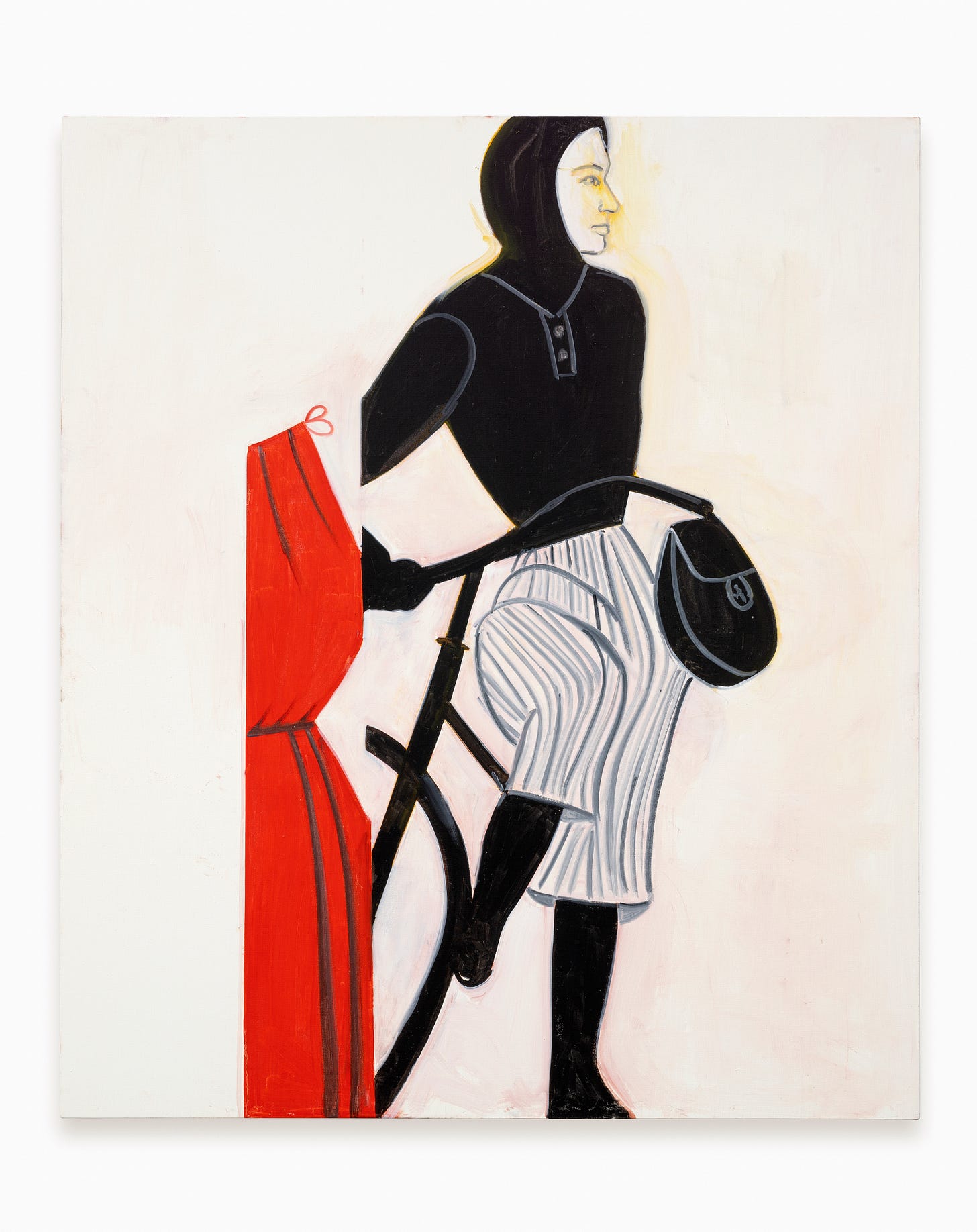
When Cécile Lempert (Millenial, German) imitates analog film in her paintings, she adds to the nostalgia of her subjects and the feeling of her scenes being frozen in time. Alex is just doing…something. On the wall label, the curator made a wild stretch to Cubism with the forms slightly resembling geometric forms due to the sequencing. Is the Cubism in the room with us?
Alex smudges yellow across the models’ faces which looks unintentional but appears as a red thread in every single work. It’s not like an aura or a halo. It’s giving snort. The canvas edges are smeary as if he reused past paintings and didn’t properly prime the canvas for the new work. The red in Claire McCardell 9 (2022) looks like Alex spilled lipstick in a Valentino white bag.
Claire McCardell 10 (2022) stood out to me as the green checkered dress is simultaneously a curtain revealing the model behind, her position almost lounging like the Venus of Urbino (1543). Claire McCardell 11 (2022) is an intriguing one as well: the brown pleated dress sandwiched between two other designs turns into an ancient Greek column.
I guess there’s a little something to Alex’s work. Maybe just enough to not throw up my hands in surrender. Where there’s a spark of creativity, there’s hope.
Alex Katz: Claire, Grass and Water is on view until September 29, 2024 at Sala Carnelutti on Isola di San Giorgio Maggiore, Venice.
Sala Carnelutti
Isola di San Giorgio Maggiore
30124 Venezia
Website
Instagram: @fondazionegcini @alexkatzofficial
I will always speak my truth on here, you can count on that. What do you think about this lil rant? Let me know in the comments. And if you enjoyed this review, let me know with a like and please share with someone who might have fun with this.
See you soon!!!
Jennifer
The Gen Z Art Critic
that’s what she said


